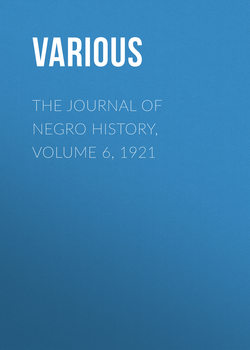Читать книгу The Journal of Negro History, Volume 6, 1921 - Various - Страница 14
The Journal of Negro History
Vol. VI—January, 1921—No. 1
NOTES
ОглавлениеThe following account of the centenary celebration of St. Philip's Episcopal Church from the New York World of November 14, 1920, will be interesting to all persons interested in Negro history:
"The Right Rev. Charles Sumner Burch, D.D., Bishop of New York, and the Right Rev. Henry Beard Delany, D.D., Suffragan Bishop of North Carolina, will participate in the centennial celebration at St. Philip's Church, No. 212 West 134th Street, the Rev. H. C. Bishop, rector, which will begin to-day.
"One hundred years ago Nov. 14 St. Philip's Church was incorporated under the laws of the State of New York. The event is significant, for it antedated the Civil War by forty-one years and the Emancipation Proclamation of Abraham Lincoln by forty-five years. It is not only, nor primarily, an ecclesiastical event, but a political and social one as well, inasmuch as this act of Legislature recognized and confirmed the citizenship of the petitioners, showing that these colored Episcopalians were an integral part of the body politic.
"It was in 1809, under the leadership of Mr. McCoombs, a lay reader, that a mission for colored people was opened in a school room on the corner of Frankfort and William Streets, where they remained until 1812, and after the death of Mr. McCoombs removed to a room in Cliff Street with Peter Williams, Jr., a colored man, as lay reader, where they remained five years, moving from there to a school room on Rose Street.
"In 1819 three lots were obtained on the west side of Collect, now Centre Street, and upon this site a wooden building was erected at a cost of $5,000. It was consecrated by Bishop John Henry Hobart, July 19, 1819, and was named St. Philip's Church. After its incorporation in 1820 Mr. Williams, who had been ordained to the Deaconate in October, was appointed minister in charge, Dec. 24, 1821, the building was destroyed by fire, but was rebuilt the following year of brick at a cost of $8,000.
"Mr. Williams was advanced to the priesthood in 1827, and became the first rector of the church. He died in 1840. In 1853 the parish was received into union with the Convention of the Diocese of New York. At that time the church was at No. 305 Mulberry Street, and the Rev. William Morris LL.D., rector of Trinity School, was the officiating minister.
"The parish was without a rector from 1840 to 1872, when the Rev. William J. Alston, trained at Kenyon College, Gambier, O., was called to the rectorship. He continued in office until 1874, and there was a vacancy until 1875, when the Rev. Joseph J. Atwell, a native of Barbados, British West Indies, was elected rector. His death in 1882 again left the office vacant until 1886, when the present incumbent, the Rev. Hutchens C. Bishop, was elected.
"During Mr. Atwell's incumbency the Parish House for Aged Women was founded. The long years of vacancy retarded the growth of the parish so that in 1885 there were but 284 communicants after a group existence of seventy-six years.
"In 1886 the congregation made another journey, locating at No. 161 West 125th Street, where it remained until 1910, when, following the migration northward, lots running from 133d to 134th Street were obtained and a commodious church and parish house were erected. The growth of the parish since that time has been phenomenal. There are now over 2,500 communicants and not room enough in the parish house to accommodate the various activities.
"At the present time St. Philip's may be said to be the only church in the neighborhood in any way equipped to serve the colored people of the community. Churchmen point out that if there is one place in Manhattan where there should be buildings adapted for indoor recreation and entertainment for the young colored people, it is that particular part of the city. They claim there should be day nurseries, gymnasiums, beneficial societies and forums for the discussion of industrial problems, where employer and employee might meet and each present his side.
"The centennial celebration will extend over a week. Bishop Burch will preach at the special thanksgiving service to-day at 11 o'clock, while Bishop Delany and one of the two negro Bishops in the Episcopal Church will make an address at the evening service.
"There will be an historical pageant to-morrow night. A public meeting with the pastors of St. Mark's, Olivet, Mother, A. M. E. Zion, St. Cyprian, George Foster Peabody and James Weldon Johnson as the speakers will take place Tuesday night. Following this meeting there will be a reception and parish supper in the basement of the church. Wednesday night is set apart for a praise service, when the Rev. Dr. Manning, Dr. Stires, Dr. Grant and Dr. Bragg will deliver addresses.
"The newly organized Provincial Conference of Church Workers Among Colored People will hold its sessions Thursday and Friday, when representative ministers and lay workers will participate. The conference will be addressed Friday night by Dr. Harry T. Ward of Union Theological Seminary and Dr. Robert Russa Moton, Principal of Tuskegee Institute."
